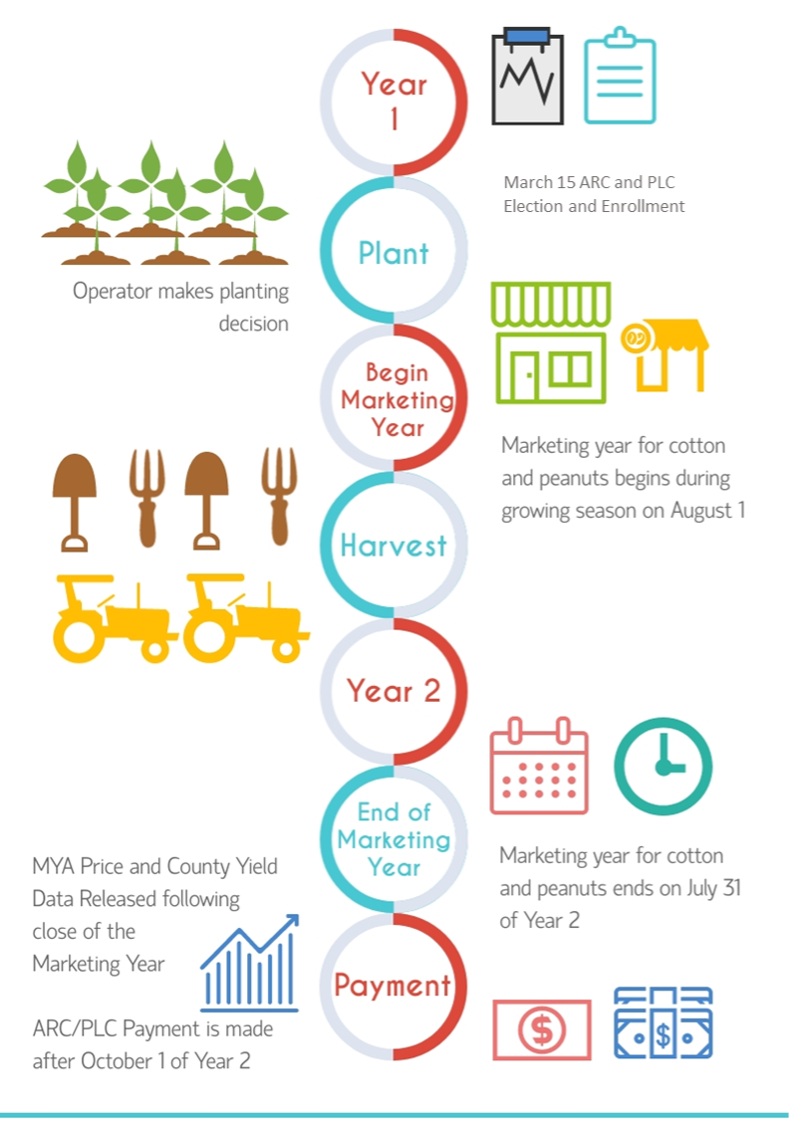The Agriculture Risk Coverage (ARC) and Price Loss Coverage (PLC) programs are vital components of the farm safety net for many producers, helping them manage the considerable risks they face. Eligible commodities for these programs include wheat, corn, sorghum, barley, oats, seed cotton, long- and medium-grain rice, certain pulses, soybeans/other oilseeds, and peanuts. Given the importance of these programs, we are often asked why the payments are made so late, generally well over a year after harvest. This article illustrates the timeline for the ARC and PLC programs, explains the reasons behind the one-year delay in payments, and examines the impact on current farm bill discussions.
Typically, prior to planting a crop, producers must make a decision (i.e., an election) between ARC and PLC on a crop-by-crop and farm-by-farm basis. They generally have until March 15 to notify USDA’s Farm Service Agency (FSA) of their election decision and to enroll in an annual ARC/PLC contract for the covered commodities for which they have base acres. Because ARC and PLC are decoupled from production, a producer’s individual production, harvesting, and marketing decisions have no bearing on ARC and PLC payments. In fact, the marketing year is standardized and does not depend on when a farmer harvests their crops on individual farms. Instead, it is based on a fixed start date specific to each commodity, which generally aligns with the typical harvest period for that crop and lasts for 12 months from this standardized start date. For example, the marketing year for cotton and peanuts starts on August 1st and lasts until the following July 31st. The national average price over this “marketing year” is then used to calculate any required ARC or PLC payments. Farmers can then expect the processing of ARC and PLC payments to occur after October 1 following the end of the marketing year, in accordance with the farm bill.
Figure 1 illustrates the timeline of the ARC and PLC programs using cotton and peanuts as examples. For the 2024 crop year, producers signed up for ARC/PLC and planted the crop this past spring. The marketing year started on August 1, 2024. Some producers (e.g., South Texas) have already harvested, and the remainder will be harvested this fall. The marketing year will continue into next year, concluding on July 31, 2025. USDA will then calculate marketing year average prices and county yields, and they will make any ARC/PLC payments after October 1, 2025. In other words, more than 18 months will have transpired between the time a producer enrolled in ARC/PLC and the time when assistance was eventually paid.
Interestingly, it hasn’t always been this way. Using the Counter-Cyclical Payments (CCP) program – the predecessor to PLC – from the 2002 Farm Bill as an illustration: the 2002 Farm Bill required USDA to make payments “as soon as practicable after the end of the 12-month marketing year for the covered commodity.” To help lessen the impact of the lagged payment timing, if the Secretary estimated that a CCP payment would be required, the 2002 Farm Bill required the Secretary to “give producers on a farm the option to receive partial payments of the [CCP] projected to be made for that crop of the covered commodity.” This all changed in the 2008 Farm Bill. The 2008 Farm Bill required any CCP payments to be made “beginning October 1, or as soon as practicable thereafter, after the end of the marketing year for the covered commodity.” In other words, payments were further delayed – until after October 1 following the end of the marketing year – and no partial/advance payments were allowed. The payment timing introduced in the 2008 Farm Bill was maintained with the creation of ARC and PLC in the 2014 Farm Bill, and it is still in place today. This all naturally leads to the question: why?
First, both ARC and PLC use the marketing year average price to determine if assistance is warranted. That necessarily means waiting until the end of the marketing year before final ARC and PLC payments can be made. While some attempts have been made to reduce the wait time – such as utilizing prices based on the first few months of the marketing year – those haven’t taken hold. Regardless, that doesn’t explain the further delay introduced in 2008. When the drafters of the 2008 Farm Bill delayed payments until after October 1, they effectively pushed payments into a subsequent fiscal year, as the federal fiscal year starts on October 1 each year. In so doing, this “timing shift” resulted in one less year of assistance that had to be funded by the 2008 Farm Bill, freeing up those resources to be used on other priorities. The problem: reversing this would result in another fiscal year of ARC/PLC assistance having to be provided by the existing farm bill budget. While complicated, it is simply a matter of policymakers deciding if it is better to use scarce resources to (1) accelerate the timing of payments or (2) make programmatic improvements like increasing reference prices. Over the last two farm bill cycles, policymakers have opted for leaving the timing alone and making programmatic improvements instead.
The more acute concern is this: even if Congress passes a new farm bill this fall (in time for the 2025 crop year), under current ARC and PLC payment timelines, producers will not see any assistance until after October 1, 2026 (the first month of fiscal year 2027). Given growing concerns about the state of the farm economy, even with a new farm bill in place, there undoubtedly will be tremendous pressure on Congress to provide ad hoc assistance for the 2024 crop year this fall, as was highlighted in a recent Southern Ag Today article, to help fill in the gap.
Figure 1. Two-Year Timeline for Key Dates of ARC and PLC Payments Using Cotton and Peanuts as an Example

Li, Yangxuan, Bart L. Fischer, and John Lai. “Timeline of the ARC and PLC Programs: Why Are Payments Received a Year Later?” Southern Ag Today 4(35.4). August 29, 2024. Permalink

Leave a Reply